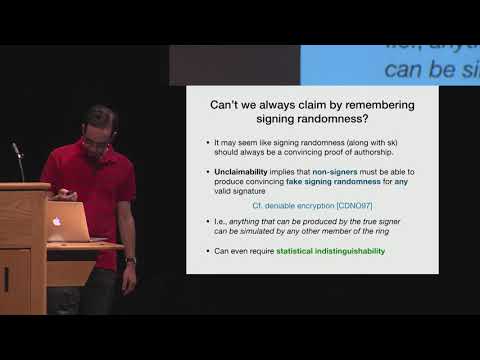CryptoDB
It Wasn’t Me!
| Authors: | |
|---|---|
| Download: |
|
| Abstract: | Ring signatures, introduced by [RST01], are a variant of digital signatures which certify that one among a particular set of parties has endorsed a message while hiding which party in the set was the signer. Ring signatures are designed to allow anyone to attach anyone else’s name to a signature, as long as the signer’s own name is also attached. But what guarantee do ring signatures provide if a purported signatory wishes to denounce a signed message—or alternatively, if a signatory wishes to later come forward and claim ownership of a signature? Prior security definitions for ring signatures do not give a conclusive answer to this question: under most existing definitions, the guarantees could go either way. That is, it is consistent with some standard definitions that a non-signer might be able to repudiate a signature that he did not produce, or that this might be impossible. Similarly, a signer might be able to later convincingly claim that a signature he produced is indeed his own, or not. Any of these guarantees might be desirable. For instance, a whistleblower might have reason to want to later claim an anonymously released signature, or a person falsely implicated in a crime associated with a ring signature might wish to denounce the signature that is framing them and damaging their reputation. In other circumstances, it might be desirable that even under duress, a member of a ring cannot produce proof that he did or did not sign a particular signature. In any case, a guarantee one way or the other seems highly desirable.In this work, we formalize definitions and give constructions of the new notions of repudiable, unrepudiable, claimable, and unclaimable ring signatures. Our repudiable construction is based on VRFs, which are implied by several number-theoretic assumptions (including strong RSA or bilinear maps); our claimable construction is a black-box transformation from any standard ring signature scheme to a claimable one; and our unclaimable construction is derived from the lattice-based ring signatures of [BK10], which rely on hardness of SIS. Our repudiable construction also provides a new construction of standard ring signatures. |
Video from CRYPTO 2019
BibTeX
@article{crypto-2019-29913,
title={It Wasn’t Me!},
booktitle={Advances in Cryptology – CRYPTO 2019},
series={Lecture Notes in Computer Science},
publisher={Springer},
volume={11694},
pages={159-190},
doi={10.1007/978-3-030-26954-8_6},
author={Sunoo Park and Adam Sealfon},
year=2019
}

